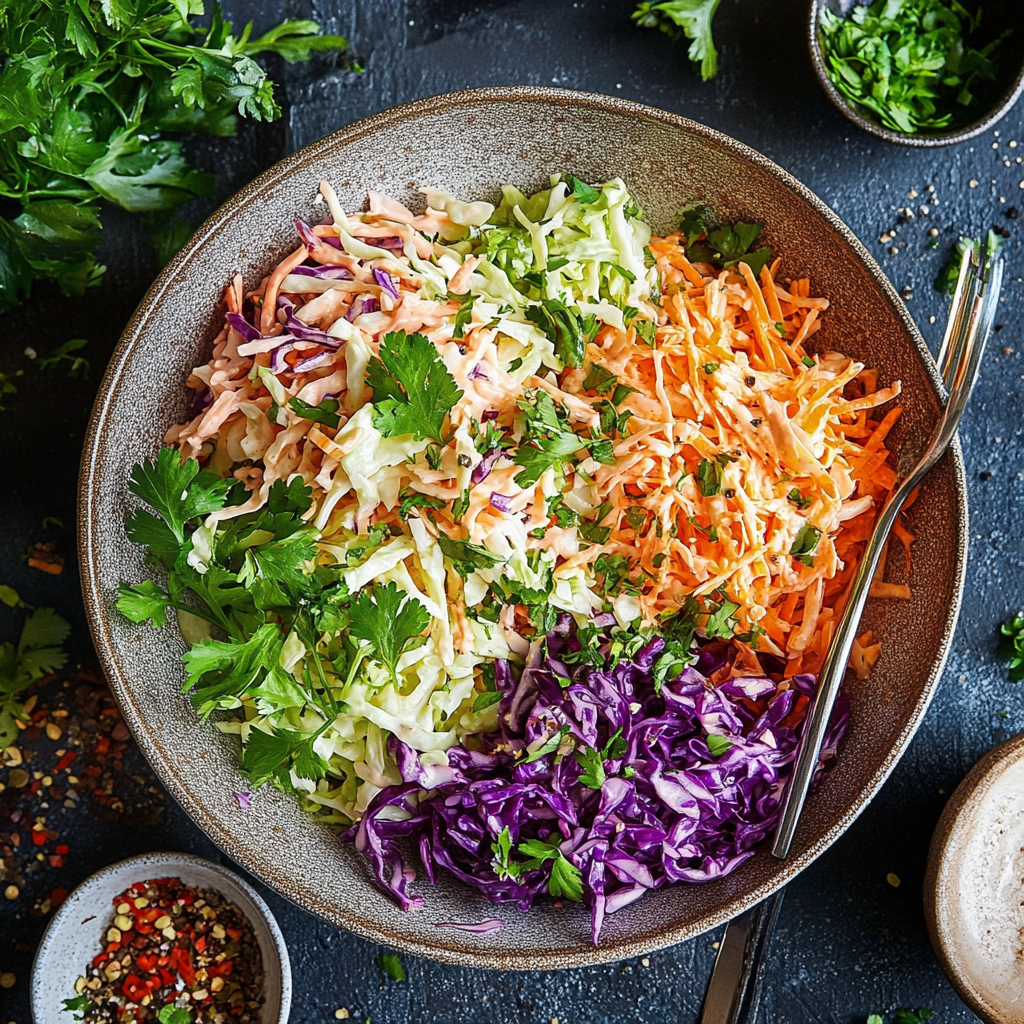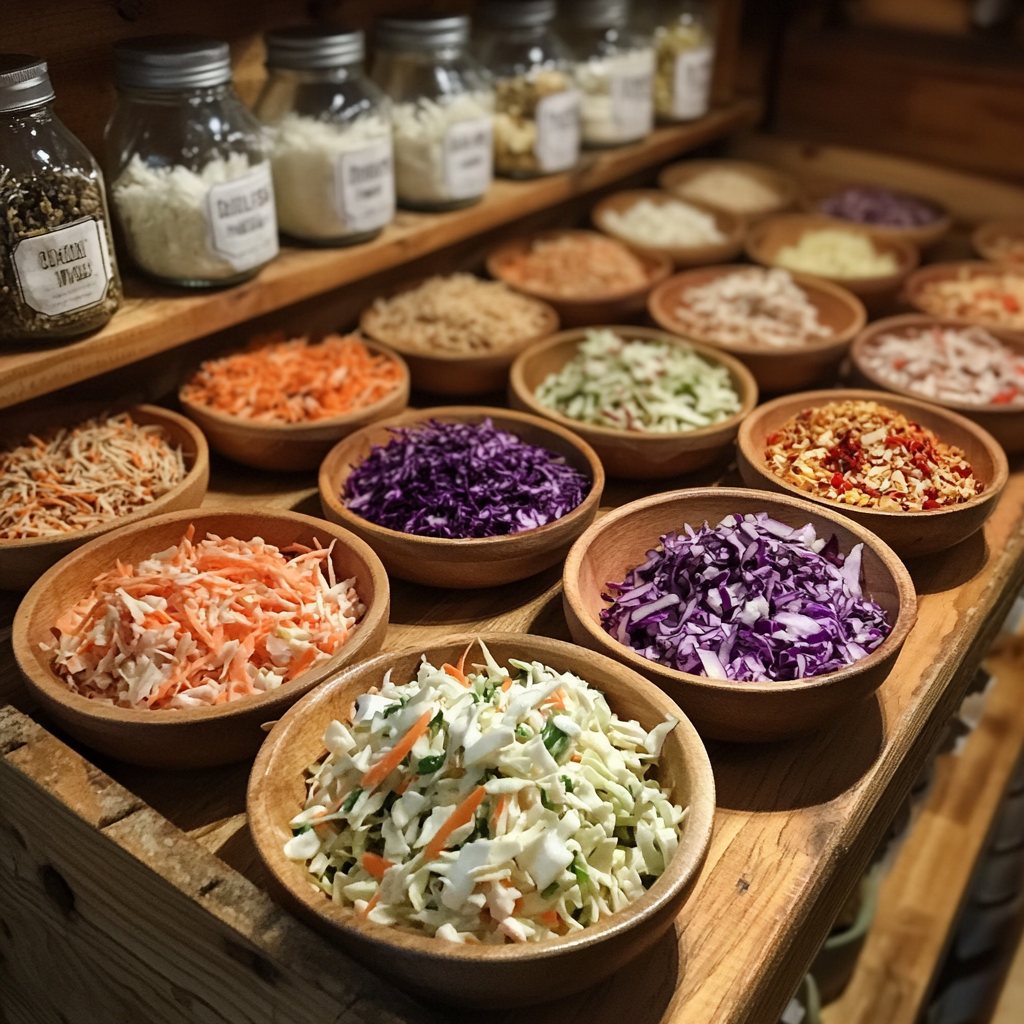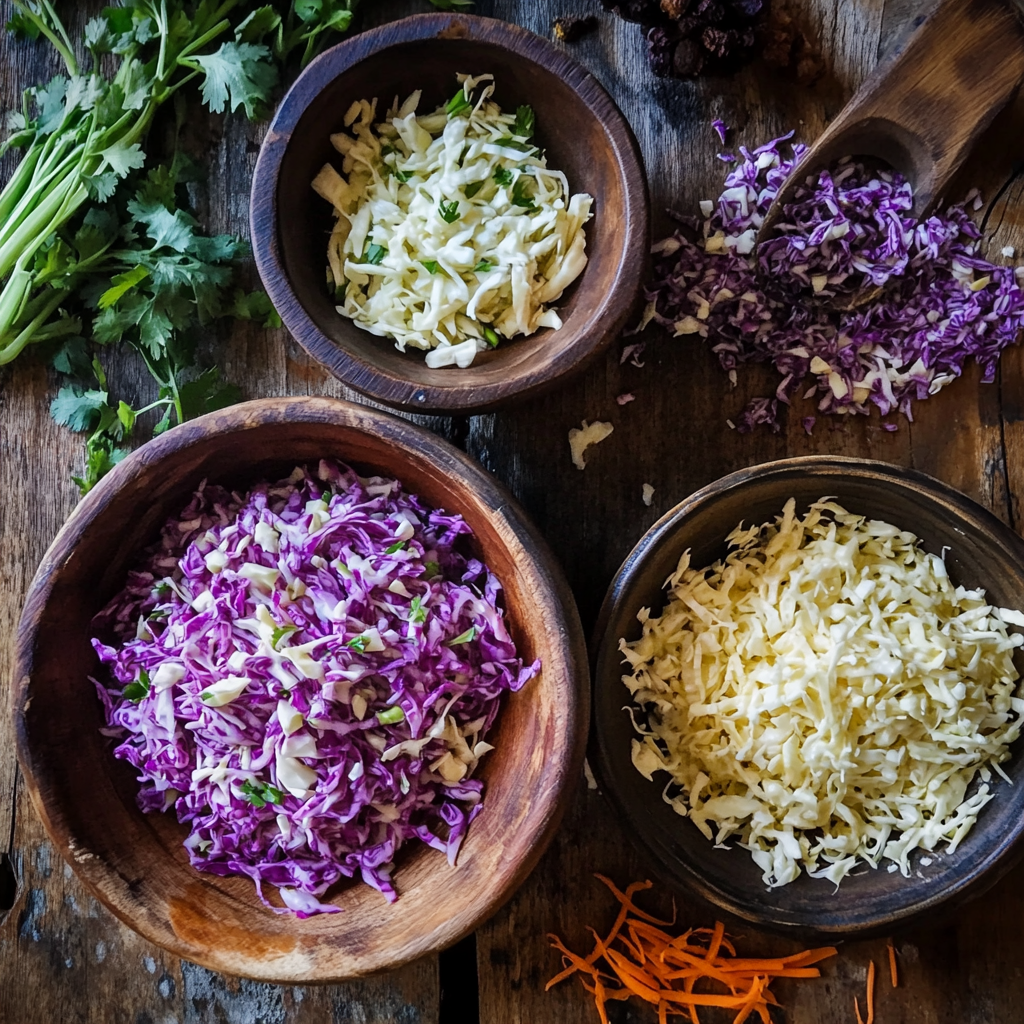
Easy Coleslaw Recipe
Table of Contents
Introduction
Coleslaw is a classic, crunchy, and creamy side dish that complements a variety of meals. Whether served at a summer barbecue, alongside fried chicken, or as a refreshing topping on a sandwich, coleslaw is a versatile favorite enjoyed worldwide.
But what exactly is coleslaw, and why is it so popular? In its simplest form, coleslaw consists of finely shredded cabbage mixed with a dressing—typically mayonnaise-based or vinegar-based. The combination of fresh vegetables and a tangy, slightly sweet dressing makes it a refreshing and flavorful side dish.
In this article, we will explore everything you need to know about coleslaw. We’ll start with its fascinating history, discuss its key ingredients, and provide a step-by-step guide to making the perfect coleslaw at home. You’ll also discover some variations and expert tips to take your coleslaw to the next level.https://savyrecipes.com/chuck-roast-shredded-recipe-steam/
History of Coleslaw
Origins of Coleslaw
The name “coleslaw” comes from the Dutch term koolsla, which means “cabbage salad.” The dish traces its roots back to the Netherlands, where early versions were made with simple ingredients like shredded cabbage, vinegar, oil, and salt. Dutch settlers brought the recipe to America in the 18th century, where it gained popularity and evolved over time.
However, coleslaw-like salads existed even earlier. Ancient Romans reportedly enjoyed a dish made of cabbage, vinegar, and eggs, similar to modern coleslaw. Across Europe, different versions of cabbage-based salads were prepared using local ingredients and flavors.
How Coleslaw Evolved Over Time
Over the years, coleslaw has undergone many transformations. In the 19th and early 20th centuries, with the rise of commercially available mayonnaise, creamy coleslaw became the dominant style in the United States. This version featured shredded cabbage mixed with mayonnaise, sugar, and sometimes mustard for extra flavor.
Today, coleslaw recipes vary widely depending on cultural influences and personal preferences. Some prefer a vinegar-based dressing for a lighter, tangier taste, while others enjoy adding ingredients like carrots, apples, or even jalapeños for extra crunch and spice. No matter the variation, coleslaw remains a beloved side dish that continues to adapt to modern tastes.
Would you like to continue with the next part, where we discuss the key ingredients and preparation steps for making the perfect coleslaw? 😊
Coleslaw in Different Cuisines
Coleslaw is a globally loved dish, but different cultures put their unique spin on it by using regional ingredients and dressings. Let’s take a look at how coleslaw is interpreted in various cuisines:
American Coleslaw
In the United States, coleslaw is typically creamy and made with a mayonnaise-based dressing. It’s a staple at barbecues, picnics, and fried chicken joints. Some variations include mustard, sugar, or buttermilk to enhance the flavor.
Dutch Coleslaw
The Dutch, who gave coleslaw its name (koolsla), traditionally prepare it with simple ingredients like cabbage, vinegar, and oil. This version is lighter and closer to the original cabbage salads eaten centuries ago.
Asian Coleslaw
Asian-inspired coleslaw swaps mayonnaise for soy sauce, sesame oil, rice vinegar, and sometimes a hint of ginger or chili. Shredded vegetables like Napa cabbage, carrots, and bell peppers are often added for extra crunch. This version pairs well with grilled meats and seafood.
Mexican Coleslaw (Ensalada de Repollo)
Mexican-style coleslaw is usually vinegar-based with lime juice, cilantro, and jalapeños for a spicy kick. It’s commonly served alongside tacos, grilled meats, or fish dishes. Some variations include a bit of mayonnaise, but the emphasis is on fresh, zesty flavors.
German Krautsalat
Germany has its own take on coleslaw called Krautsalat, which features shredded cabbage mixed with vinegar, oil, salt, and caraway seeds. It is often served warm or cold as a side dish to sausages and schnitzels.
Korean Baechu Salad
A spicy Korean variation of coleslaw includes Napa cabbage, gochugaru (Korean chili flakes), garlic, and a soy sauce-based dressing. This version resembles a fresh, quick-pickled kimchi and is a great side dish for Korean barbecue.
Types of Coleslaw
There are several types of coleslaw, each with a unique flavor profile based on the dressing and additional ingredients used.
Creamy Coleslaw
The most common type, creamy coleslaw, is made with a mayonnaise-based dressing. Other ingredients like buttermilk, sour cream, or mustard can be added for extra flavor. The dressing is often slightly sweetened with sugar or honey and balanced with vinegar or lemon juice.
Vinegar-Based Coleslaw
This lighter, tangier version replaces mayonnaise with a vinegar-based dressing, typically made with apple cider vinegar, olive oil, and spices. It has a crisp, refreshing taste and is popular in Southern and barbecue-style meals.

Spicy Coleslaw Variations
For those who enjoy bold flavors, spicy coleslaw adds ingredients like jalapeños, Sriracha, chili powder, or hot sauce. This variation pairs well with grilled meats, tacos, and sandwiches.
Healthy Coleslaw Alternatives
For a healthier take, some coleslaw recipes substitute mayonnaise with Greek yogurt, avocado, or a light vinaigrette. Additional superfoods like kale, Brussels sprouts, or shredded apples can be included for extra nutrition.
Would you like to continue with the next part, where we discuss a step-by-step guide to making the perfect coleslaw at home? 😊
Here’s a detailed breakdown of how to customize your coleslaw recipe and avoid common mistakes!
Customizing Your Coleslaw Recipe
Coleslaw is a classic side dish that can be easily adjusted to suit different tastes and dietary needs. Whether you prefer it sweet, tangy, creamy, or crunchy, there are plenty of ways to make coleslaw your own.
Adjusting Sweetness and Tanginess
The balance between sweetness and tanginess is key to a perfect coleslaw. Here’s how to tweak it:
- For more sweetness – Add honey, maple syrup, or a bit of sugar to the dressing. You can also use naturally sweet ingredients like shredded apples or raisins.
- For more tanginess – Increase the amount of vinegar (apple cider vinegar works great) or add a squeeze of fresh lemon juice. Dijon mustard can also add a subtle tangy kick.
- Balanced flavor – A mix of mayo, vinegar, and a small amount of sugar usually creates a well-rounded flavor profile.
Making Coleslaw Dairy-Free or Vegan
Traditional coleslaw recipes often use mayonnaise, which contains eggs. Here’s how to make it plant-based:
- Dairy-free alternatives – Use a mayo substitute like avocado-based mayo, olive oil, or a tahini-based dressing.
- Vegan options – Try vegan mayo or make a creamy dressing with blended cashews, coconut yogurt, or silken tofu.
- Oil-based coleslaw – Skip the creaminess altogether and use a vinaigrette dressing made from olive oil, vinegar, mustard, and seasonings.
Adding Fruits or Nuts for Extra Crunch
To make coleslaw more exciting, add:
- Fruits – Apples, pears, raisins, cranberries, or pineapple chunks for a touch of natural sweetness.
- Nuts and seeds – Almonds, walnuts, pecans, sunflower seeds, or pumpkin seeds add crunch and depth of flavor.
- Additional veggies – Shredded Brussels sprouts, carrots, bell peppers, or radishes can enhance both texture and taste.
Using Different Herbs and Spices for Unique Flavors
Coleslaw doesn’t have to be plain—spices and herbs can take it to the next level!
- Fresh herbs – Cilantro, parsley, dill, or chives add freshness.
- Spices – A pinch of cumin, smoked paprika, or celery seed can enhance the flavor.
- Heat – Add a bit of chopped jalapeño, a dash of hot sauce, or red pepper flakes for a spicy kick.
Common Mistakes to Avoid
Even a simple dish like coleslaw can go wrong if not prepared correctly. Here are some pitfalls to watch out for:
Using Too Much Dressing
- Overdressing makes coleslaw soggy. Start with a small amount and gradually add more as needed.
- If the coleslaw sits too long, the cabbage will release moisture, making it even wetter. Try dressing it just before serving.
Not Letting It Chill Before Serving
- Letting coleslaw sit in the fridge for at least 30 minutes helps the flavors meld together.
- Coleslaw tastes best when it’s cold, so refrigerate it before serving, especially if you’ve just mixed in the dressing.
Over-Shredding the Cabbage
- Finely shredded cabbage can turn mushy quickly. Aim for thin, even slices rather than tiny pieces.
- Use a sharp knife, mandoline slicer, or a food processor with a slicing attachment instead of grating it.
Would you like me to continue with Best Ways to Serve Coleslaw and Storing and Making Coleslaw Ahead of Time? 😊
Common Mistakes to Avoid (Continued)
Making Coleslaw Too Watery
A watery coleslaw can ruin the texture and dilute the flavors. Here’s how to prevent excess moisture:
- Salt the cabbage first – Sprinkle a little salt over the shredded cabbage and let it sit for 10–15 minutes. This draws out excess water. Rinse and pat dry before adding the dressing.
- Use thicker dressings – A dressing with too much vinegar or a thin consistency will become runny. Use Greek yogurt, sour cream, or mayo-based dressings for a creamier consistency.
- Drain before serving – If coleslaw sits for too long, it releases water. Before serving, drain any excess liquid and stir the salad to refresh its texture.
Best Ways to Serve Coleslaw
Coleslaw is a versatile dish that pairs well with many foods. Here are some of the best ways to enjoy it:
As a Side Dish for BBQ and Grilled Meats
- A classic pairing with ribs, pulled pork, brisket, and grilled chicken.
- The fresh crunch and slight acidity of coleslaw balance the smoky, rich flavors of BBQ.
Inside Sandwiches and Tacos
- Add coleslaw to pulled pork, chicken, or brisket sandwiches for extra texture and flavor.
- Works great in tacos, especially with fish or shrimp, adding crunch and freshness.
With Fried Foods Like Fish and Chicken
- Fried fish, crispy chicken, and coleslaw are a match made in heaven. The acidity cuts through the richness of fried foods.
- Try serving coleslaw alongside fish and chips, fried shrimp, or crispy chicken tenders.
As a Topping for Burgers and Hot Dogs
- Replace lettuce with coleslaw on burgers for an added crunch.
- Pile it onto hot dogs for a Carolina-style twist.
Storing and Making Coleslaw Ahead of Time
If you want to prepare coleslaw in advance or store leftovers properly, follow these guidelines.
How Long Coleslaw Lasts in the Fridge
- Homemade coleslaw typically lasts 3–5 days in the fridge.
- If it starts smelling sour or looking too watery, it’s best to discard it.
- For the best flavor and texture, consume coleslaw within the first 24–48 hours.
Best Containers for Storage
- Airtight containers – Keep coleslaw fresh by storing it in a sealed glass or plastic container.
- Mason jars – Great for individual servings and maintaining freshness.
- Avoid metal containers – Metal can react with acidic dressings and alter the taste.
Can You Freeze Coleslaw?
- Mayo-based coleslaw: Not recommended for freezing as the dressing can separate and become grainy.
- Vinegar-based coleslaw: Freezes better because there’s no dairy or eggs to break down. Store in a freezer-safe bag or container for up to 2 months.
- How to thaw: Defrost in the fridge overnight and stir well before serving.
Would you like me to add more details or provide additional serving suggestions? 😊
It looks like you’re looking for answers to common questions about coleslaw and a conclusion summarizing the best tips. Here’s a detailed response to each FAQ, along with a well-rounded conclusion:
Frequently Asked Questions (FAQs)
How do I prevent coleslaw from getting watery?
Coleslaw becomes watery when the cabbage releases moisture after being mixed with dressing. To prevent this:
- Salt the cabbage first: Sprinkle a little salt on the shredded cabbage and let it sit for about 30 minutes. Then, rinse and pat dry before adding the dressing.
- Use a thicker dressing: Mayonnaise-based dressings hold up better than vinegar-based ones, which can draw out more moisture.
- Serve fresh: Coleslaw is best when served soon after mixing. If making ahead, store the dressing separately and mix just before serving.
What is the healthiest dressing option for coleslaw?
For a healthier coleslaw, consider these dressing alternatives:
- Greek yogurt-based dressing: Lower in fat and high in protein.
- Olive oil and vinegar dressing: A heart-healthy option that adds tangy flavor.
- Avocado dressing: A creamy, dairy-free option with healthy fats.
- Light mayonnaise: If you prefer the classic taste but want a lighter version.
Can I use Greek yogurt instead of mayonnaise?
Yes! Greek yogurt is a great substitute for mayonnaise. It provides a creamy texture with added protein and less fat. If you prefer a balance between taste and health, try a half-mayo, half-yogurt mix to keep the traditional coleslaw flavor while making it lighter.
How far in advance can I make coleslaw?
Coleslaw can be made in advance, but to keep it fresh and crisp:
- Without dressing: Store shredded cabbage and vegetables separately for up to 3-4 days in the fridge.
- With dressing: If already mixed, coleslaw is best within 24 hours but can last up to 2 days. If stored longer, it may become soggy.
What is the best cabbage variety for coleslaw?
The best cabbage for coleslaw depends on your preference:
- Green cabbage: The most common choice with a slightly sweet and crunchy texture.
- Red cabbage: Adds color and a peppery taste but can bleed into the dressing.
- Savoy cabbage: More tender with a milder flavor, ideal for a softer coleslaw.
- Napa cabbage: Offers a delicate, slightly sweeter taste with a softer bite.

Conclusion
Recap of the Best Tips for Making Coleslaw
- Use fresh, crisp cabbage for the best texture.
- Salt and drain the cabbage to prevent a watery coleslaw.
- Choose a dressing that fits your preference, from classic mayo to healthier yogurt or vinaigrette options.
- Store ingredients separately if making ahead to maintain freshness.
Encouragement to Try Different Variations
Coleslaw is a versatile dish that allows for endless creativity. Experiment with:
- Adding fruits like apples or raisins for sweetness.
- Spicing it up with jalapeños or a dash of hot sauce.
- Trying different dressings like Asian sesame or honey mustard.
Final Thoughts on Coleslaw as a Versatile Dish
Whether you enjoy it creamy, tangy, sweet, or spicy, coleslaw is an easy-to-make side dish that complements everything from BBQ to sandwiches. By tweaking ingredients and flavors, you can create a coleslaw that suits any occasion and dietary preference. So, don’t hesitate to mix things up and find your perfect coleslaw recipe!
Would you like any specific coleslaw recipes or more tips on customization? 😊https://www.allrecipes.com/recipe/73009/quick-and-easy-thai-style-coleslaw/
